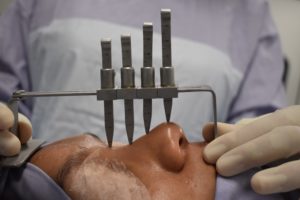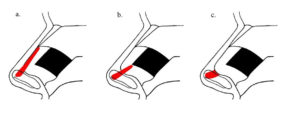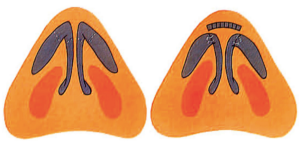Introduction Rhinoplasty is an operation of many intricate complexities that also remains as much of an art as a science wherein “just enough, but not too much” manipulation of various structures is required for optimal outcomes. Surgical challenges that are critical to outcomes that may be addressed during rhinoplasty include, among others, management of the… [Read More]
Nasal Tip & Aesthetics
Nasal tip surgery in the hispanic population
Abstract The current ideal nose is straight with a well-defined projected tip, covered with thin skin under which the osteocartilaginous support protrudes giving an impression of angularity. The radix should be located at the level of the upper edge of tarsal cartilage of the upper eyelid and the nasolabial angle should be between 90°–100°. To… [Read More]
Nuances associated with Septocolumellar sutures
Introduction Ideal positioning of the nasal tip is a very important element to a successful rhinoplasty. Tip projection, rotation, angulation of the infratip lobule, and the columellar-labial junction are controlled by the surgeon. There are numerous methods described in the literature regarding tip stabilization[1][2][3][4]. These include but are not limited to, medial crura binding suture,… [Read More]
Long term evaluation of the Goldman nasal tip procedure. A ten-year follow-up
Abstract Many skilled surgeons are hesitant to apply the Goldman technique to their patients in fear of the consequences on the external nasal valve and overall to the nasal patency due to the fact, that it is an irreversible technique. In this study we prove that these fears are unjustified because both the aesthetic and… [Read More]
Nasal Tip Contour and Support Management
ABSTRACT The “structure rhinoplasty” avoids the typical unfavorable outcomes resulting from old fashion “resective techniques”. Reconstructing the nose with support tip grafts helps us to be more accurate in projection, rotation and definition. In 2009 we started to use septal extension graft (SEG), which was the milestone to get more predictable long term tip projection… [Read More]
Seeing through the Envelope: The Cartilage Shape Requirements for an Aesthetically Pleasing Nasal Tip
1. Anatomy and Structure of the Nasal Tip The nasal architecture is complex, and assessing its external appearance requires critical understanding of the underlying structure. Although the aesthetic goal of rhinoplasty surgeries sets the framework for the task at hand, the inherent anatomy often guides the operative technique1,2. Its composition of skin, fibrofatty soft tissue,… [Read More]
Supporting the Nasal Tip
Intro/Background: Controlling the shape and position of the nasal tip has been described as the single greatest challenge in rhinoplasty. In his textbook, Surgical Anatomy of the Nose, Tardy states it is impossible to sculpt the nasal tip and predict healing without completely understanding the tip support mechanisms of the nose1. Whether performing an open… [Read More]
Cranial Tip Sutures for Tip Refinement
Introduction Nasal tip refinement techniques have continued to evolve over recent decades.1 Reshaping of the tip of the nose must be carefully and precisely performed, as there are numerous aesthetic and functional implications. In this article, we focus on a transformative nasal tip technique called the Cranial Tip Suture, originally described in a 210 patient… [Read More]
Mechanisms of Nasal Tip Deprojection: An Overview
Nasal surgery can be traced back to ancient Egyptian hieroglyphics in 600 B.C. Roe was the first to describe a surgical approach to alteration of the nasal tip in 1887, which was later optimized by Joseph—widely recognized as the father of modern corrective rhinoplasty.1 One of the most challenging elements of rhinoplasty is aesthetic optimization… [Read More]
Nasal Tip Sutures
In this chapter we will comment on the major sutures performed to achieve a proper nasal tip definition. Transdomal suture Transdomal sutures (TDS) are used to increase tip projection, narrow the distance between the domes and helps to form the tip double break and provide a better tip-columella relation. The transdomal sutures are effective in… [Read More]










